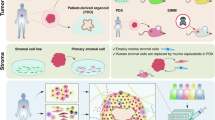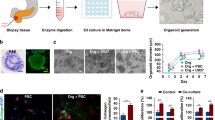Abstract
The role of stromal cells in the tumor microenvironment has been extensively characterized. We and others have shown that stromal cells may participate in several steps of the metastatic cascade. This protocol describes an isolated tumor perfusion model that enables studies of cancer and stromal cell shedding. It could also be used to study the effects of therapies interfering with the shedding of tumor cells or fragments, circulating (stem) cells or biomarkers. Primary tumors are grown in a microenvironment in which stromal cells express GFP ubiquitously. Tumors are implanted orthotopically or can be implanted ectopically. As a result, all tumor-associated stromal cells express GFP. This technique can be used to detect and study the role of stromal cells in tumor fragments within the circulation in mice. Studying the role of stromal cells in circulating tumor fragments using this model may take 2–10 weeks, depending on the growth rate of the primary tumor.
This is a preview of subscription content, access via your institution
Access options
Subscribe to this journal
Receive 12 print issues and online access
$259.00 per year
only $21.58 per issue
Buy this article
- Purchase on Springer Link
- Instant access to full article PDF
Prices may be subject to local taxes which are calculated during checkout




Similar content being viewed by others
References
Barcellos-Hoff, M.H. & Ravani, S.A. Irradiated mammary gland stroma promotes the expression of tumorigenic potential by unirradiated epithelial cells. Cancer Res. 60, 1254–1260 (2000).
Bhowmick, N.A. et al. TGF-β signaling in fibroblasts modulates the oncogenic potential of adjacent epithelia. Science 303, 848–851 (2004).
Coussens, L.M. & Werb, Z. Inflammation and cancer. Nature 420, 860–867 (2002).
Jacobs, T.W., Byrne, C., Colditz, G., Connolly, J.L. & Schnitt, S.J. Radial scars in benign breast-biopsy specimens and the risk of breast cancer. N. Engl. J. Med. 340, 430–436 (1999).
Elenbaas, B. et al. Human breast cancer cells generated by oncogenic transformation of primary mammary epithelial cells. Genes Dev. 15, 50–65 (2001).
Bouvet, M. et al. In vivo color-coded imaging of the interaction of colon cancer cells and splenocytes in the formation of liver metastases. Cancer Res. 66, 11293–11297 (2006).
Bhowmick, N.A., Neilson, E.G. & Moses, H.L. Stromal fibroblasts in cancer initiation and progression. Nature 432, 332–337 (2004).
Olumi, A.F. et al. Carcinoma-associated fibroblasts direct tumor progression of initiated human prostatic epithelium. Cancer Res. 59, 5002–5011 (1999).
Orimo, A. et al. Stromal fibroblasts present in invasive human breast carcinomas promote tumor growth and angiogenesis through elevated SDF-1/CXCL12 secretion. Cell 121, 335–348 (2005).
Tlsty, T.D. Stromal cells can contribute oncogenic signals. Semin. Cancer Biol. 11, 97–104 (2001).
Fidler, I.J. The pathogenesis of cancer metastasis: the ′seed and soil′ hypothesis revisited. Nat. Rev. Cancer 3, 453–458 (2003).
Fukumura, D. et al. Tumor induction of VEGF promoter activity in stromal cells. Cell 94, 715–725 (1998).
Joyce, J.A. & Pollard, J.W. Microenvironmental regulation of metastasis. Nat. Rev. Cancer 9, 239–252 (2009).
Podsypanina, K. et al. Seeding and propagation of untransformed mouse mammary cells in the lung. Science 321, 1841–1844 (2008).
Hiratsuka, S. et al. MMP9 induction by vascular endothelial growth factor receptor-1 is involved in lung-specific metastasis. Cancer Cell 2, 289–300 (2002).
Kaplan, R.N. et al. VEGFR1-positive haematopoietic bone marrow progenitors initiate the pre-metastatic niche. Nature 438, 820–827 (2005).
Kim, S. et al. Carcinoma-produced factors activate myeloid cells through TLR2 to stimulate metastasis. Nature 457, 102–106 (2009).
van Deventer, H.W. et al. C-C chemokine receptor 5 on pulmonary fibrocytes facilitates migration and promotes metastasis via matrix metalloproteinase 9. Am. J. Pathol. 173, 253–264 (2008).
Al-Mehdi, A.B. et al. Intravascular origin of metastasis from the proliferation of endothelium-attached tumor cells: a new model for metastasis. Nat. Med. 6, 100–102 (2000).
Liotta, L.A., Saidel, M.G. & Kleinerman, J. The significance of hematogenous tumor cell clumps in the metastatic process. Cancer Res. 36, 889–894 (1976).
Fidler, I.J. The relationship of embolic homogeneity, number, size and viability to the incidence of experimental metastasis. Eur. J. Cancer 9, 223–227 (1973).
Ruiter, D.J., van Krieken, J.H., van Muijen, G.N. & de Waal, R.M. Tumour metastasis: is tissue an issue? Lancet Oncol. 2, 109–112 (2001).
Sahai, E. Illuminating the metastatic process. Nat. Rev. Cancer 7, 737–749 (2007).
Duyverman, A.M., Steller, E.J., Fukumura, D., Jain, R.K. & Duda, D.G. Studying carcinoma-associated fibroblast involvement in cancer metastasis in mice. Nat. Protoc. 7, 756–762 (2012).
Duyverman, A.M.M.J., Kohno, M., Duda, D.G., Jain, R.K. & Fukumura, D. A transient parabiosis skin transplantation model in mice. Nat. Protoc. 7, 763–770 (2012).
Duda, D.G. et al. Malignant cells facilitate lung metastasis by bringing their own soil. Proc. Natl Acad. Sci. USA 107, 21677–21682 (2010).
Nakhasi, H.L., Grantham, F.H. & Gullino, P.M. Expression of κ-casein in normal and neoplastic rat mammary gland is under the control of prolactin. J. Biol. Chem. 259, 14894–14898 (1984).
Gullino, P.M. Tumor pathophysiology: the perfusion model. Antibiot. Chemother. 28, 35–42 (1980).
Gullino, P.M. & Grantham, F.H. Studies on the exchange of fluids between host and tumor. I. A method for growing 'tissue-isolated' tumors in laboratory animals. J. Natl. Cancer Inst. 27, 679–693 (1961).
Kristensen, C.A., Roberge, S. & Jain, R.K. Effect of tumor necrosis factor alpha on vascular resistance, nitric oxide production, and glucose and oxygen consumption in perfused tissue-isolated human melanoma xenografts. Clin. Cancer Res. 3, 319–324 (1997).
Bayless, K.J., Kwak, H.I. & Su, S.C. Investigating endothelial invasion and sprouting behavior in three-dimensional collagen matrices. Nat. Protoc. 4, 1888–1898 (2009).
Albini, A. & Benelli, R. The chemoinvasion assay: a method to assess tumor and endothelial cell invasion and its modulation. Nat. Protoc. 2, 504–511 (2007).
Proia, D.A. & Kuperwasser, C. Reconstruction of human mammary tissue in a mouse model. Nat. Protoc. 1, 206–214 (2006).
Bockhorn, M., Roberge, S., Sousa, C., Jain, R.K. & Munn, L.L. Differential gene expression in metastasizing cells shed from kidney tumors. Cancer Res. 64, 2469–2473 (2004).
Swartz, M.A. et al. Cells shed from tumours show reduced clonogenicity, resistance to apoptosis, and in vivo tumorigenicity. Br. J. Cancer 81, 756–759 (1999).
Acknowledgements
The work of the authors is supported by US National Cancer Institute grants P01-CA80124, R01-CA115767, R01-CA85140, R01-CA126642 and T32-CA73479 (R.K.J.), R01-CA96915 (D.F.), R21-CA139168 and R01-CA159258 (D.G.D.) and Federal Share Proton Beam Program grants (R.K.J., D.F. and D.G.D.); Department of Defense Innovator Award W81XWH-10-1-0016 (R.K.J.) and Predoctoral Fellowship W81XWH-06-1-0781 (A.M.M.J.D.); American Cancer Society grant RSG-11-073-01TBG (D.G.D.); and Stichting Michael Van Vloten Fonds and the Stichting Jo Kolk (A.M.M.J.D.). We acknowledge the outstanding technical assistance of J. Kahn and P. Huang with animal models.
Author information
Authors and Affiliations
Contributions
D.G.D., D.F. and R.K.J. designed the studies; A.M.M.J.D., S.R. and M.K. performed the experiments; D.G.D., D.F., A.M.M.J.D., M.K. and R.K.J. analyzed the data; and A.M.M.J.D., D.G.D., D.F. and R.K.J. edited the manuscript.
Corresponding author
Ethics declarations
Competing interests
The authors declare no competing financial interests.
Rights and permissions
About this article
Cite this article
Duyverman, A., Kohno, M., Roberge, S. et al. An isolated tumor perfusion model in mice. Nat Protoc 7, 749–755 (2012). https://doi.org/10.1038/nprot.2012.030
Published:
Issue Date:
DOI: https://doi.org/10.1038/nprot.2012.030
This article is cited by
-
Microfluidic Isolation of Circulating Tumor Cell Clusters by Size and Asymmetry
Scientific Reports (2017)
-
Studying primary tumor–associated fibroblast involvement in cancer metastasis in mice
Nature Protocols (2012)
-
A transient parabiosis skin transplantation model in mice
Nature Protocols (2012)
Comments
By submitting a comment you agree to abide by our Terms and Community Guidelines. If you find something abusive or that does not comply with our terms or guidelines please flag it as inappropriate.



